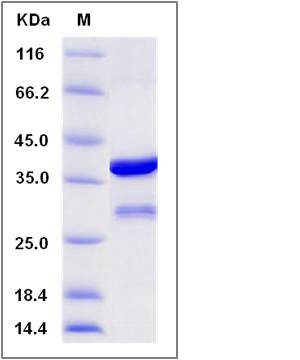Human BLOC1S2 / BLOS2 Protein (GST Tag)
BLOS2,CEAP,CEAP11
- 100ug (NPP1930) Please inquiry
| Catalog Number | P13916-H09E |
|---|---|
| Organism Species | Human |
| Host | E. coli |
| Synonyms | BLOS2,CEAP,CEAP11 |
| Molecular Weight | The recombinant human BLOC1S2 /GST chimera consists of 333 amino acids and has a predicted molecular mass of 38.7 kDa. It migrates as an approximately 39 KDa band in SDS-PAGE under reducing conditions. |
| predicted N | Met |
| SDS-PAGE |  |
| Purity | > 74 % as determined by SDS-PAGE |
| Protein Construction | A DNA sequence encoding the human BLOC1S2 (Q6QNY1-2) (Met1-Arg99) was fused with the GST tag at the N-terminus. |
| Bio-activity | |
| Research Area | Cancer |Signal transduction |Protein Trafficking |Organelle Proteins |
| Formulation | Lyophilized from sterile PBS, pH 7.4 1. Normally 5 % - 8 % trehalose, mannitol and 0.01% Tween80 are added as protectants before lyophilization. Specific concentrations are included in the hardcopy of COA. |
| Background | BLOC1S2, also known as BLOS2, belongs to the BLOC1S2 family. It is a component of BLOC-1 complex. The BLOC-1 complex is composed of BLOC1S1, BLOC1S2, BLOC1S3, DTNBP1, MUTED, PLDN, CNO/cappuccino and SNAPIN. The BLOC-1 complex is required for normal biogenesis of lysosome-related organelles, such as platelet dense granules and melanosomes. BLOC1S2 interacts directly with BLOC1S1, BLOC1S3, MUTED, CNO/cappuccino and SNAPIN. It may play a role in cell proliferation. It also plays a role in intracellular vesicle trafficking. Functionally, BLOC1S2 gene has been proposed to participate in processes (melanosome organization, microtubule nucleation, platelet dense granule organization, positive regulation of cell proliferation, positive regulation of transcription, regulation of apoptosis, positive regulation of transcription from RNA polymerase II promoter). |
| Reference |
